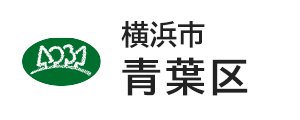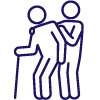- Yokohama-shi Top Page
- Aoba Ward Top Page
- Health, medical care, welfare
- Welfare, care
- Community welfare and health
- Aoba Ward Disaster Assistance Guide for advocate
- Welfare refuge (Special evacuation sites)
The text is from here.
Welfare refuge (Special evacuation sites)
Last updated on September 19, 2024.
For those who have difficulty evacuating at evacuation shelter or at home in the event of a large-scale disaster, Yokohama has concluded agreements with social welfare facilities in the city and positioned it as a special evacuation sites.
From April 2018, the name will be changed to "welfare shelter" widely used throughout the country.
(1) What is the Welfare refuge (Special evacuation sites)?
- If a large-scale disaster causes enormous damage and becomes unable to live at home, you will have to live an evacuation life in evacuation shelter, such as elementary and junior high schools.
- For those in need of advocate, such as the elderly, children with disabilities, pregnant women and infants, those who have difficulty in evacuation at gymnasiums, each evacuation shelter will have space for advocate.
→Nevertheless, welfare refuge is a secondary refuge to accommodate those who find it difficult to evacuate in evacuation shelter.
(2) Evacuation to Welfare refuge
- Those who have difficulty maintaining their lives at evacuation shelter or at home and need special care.
- Professionals (public health nurses) check the situation of the individual and whether they are certified as requiring nursing care, and determine the necessity of evacuation to the welfare refuge.
- In order for the welfare refuge to fulfill the necessary functions and roles, those who are not considered eligible cannot evacuate.
- Welfare refuge is not always established immediately after a disaster.
- In principle, travel from evacuation shelter must be done by the person or family.
(3) Target facilities
Social welfare facilities that have concluded agreements with the ward office (elderly facilities, facilities for the disabled, community care plazas, etc.)
(4) Q&As
Q: What kind of facility is a welfare shelter? What kind of equipment and support do you have?
A: It is social welfare facilities such as facilities for the elderly, facilities for the disabled, and community care plazas that have concluded agreements with the ward office.
We can provide assistance to the extent possible, depending on the conditions of the facilities, in an environment where advocate needs to live easily, such as barrier-free facilities.
Even in the welfare refuge, you will have to work with the surrounding refugee to live an evacuation life while helping each other.
Q: When will welfare refuge be opened? Who can evacuate?
A: Welfare refuge is not always established immediately after a disaster.
The ward office requests the establishment sequentially from facilities that have been confirmed and have been prepared for operation.
In order to make effective use of limited resources, it is necessary to identify the situation in advocate after the disaster and evacuate from those with higher priority.
Q: What are the criteria for accepting welfare refuge? Who decides how and how?
A: Since the facilities that serve as welfare refuge are limited, it is difficult to accept all eligible advocate at once.
Professionals (public health nurses) judge those who have evacuated to evacuation shelter (or from information on advocate collected in evacuation shelter) who need more support.
Based on the judgment of professionals, etc., the ward office decides who to accept at which welfare evacuation center.
(5) Agreement concluded facilities
| Facility type | Name | Location |
|---|---|---|
| Special elderly nursing homes※ | Hikari-en | 8-4, Satsukigaoka, Aoba-ku |
| Special elderly nursing homes※ | A green town | 2075-3, Kuroganecho, Aoba-ku |
| Special elderly nursing homes※ | Forest of Velde | 548-2, Jikecho, Aoba-ku |
| Special elderly nursing homes※ | Green leaves | 4-6-1, Nara, Aoba-ku |
| Special elderly nursing homes※ | Tama Plaza Club | 3697-1, Motoishikawacho, Aoba-ku |
| Special elderly nursing homes※ | A garden | 2578, Naracho, Aoba-ku |
| Special elderly nursing homes※ | Taiki no Sato, a nursing home for the elderly | 2282, Ondacho, Aoba-ku |
| Special elderly nursing homes※ | Soseien Aoba | 881-13, Naracho, Aoba-ku |
| Special elderly nursing homes※ | Misuzugaoka | 23-2, Misuzugaoka, Aoba-ku |
| Nursing care facilities for the elderly | Aoba Hill | 6568, Motoishikawacho, Aoba-ku |
| Nursing care facilities for the elderly | Yokohama Aoba no Sato | 1375, Kuroganecho, Aoba-ku |
| Nursing care facilities for the elderly | Reha Resort Aoba | 4-6-13, Nara, Aoba-ku |
| Nursing care facilities for the elderly | Yokohama Silver Plaza | 2075-5, Kuroganecho, Aoba-ku |
| Nursing care facilities for the elderly | Platinum Villa Aobadai | 75-1, Kamoshidacho, Aoba-ku |
| Elderly Welfare Center | Utopia Aoba | 4-2, Moegino, Aoba-ku |
| Support facilities for persons with disabilities | Aoba maison | 1757-3, Naracho, Aoba-ku |
| Home for Persons with Disabilities | Eda welfare home | 494-7, Edacho, Aoba-ku |
| Home for Persons with Disabilities | Aoba Local Activities Home Step | 2-8-22, Aobadai, Aoba-ku |
| Mental Handicapped Life Support Center | Aoba Ward Life Support Center Hot Salon Aoba | 2-14-3, Edanishi, Aoba-ku |
| elementary school student Development Support Center | Regional nursing center Aoba | 34-1, Kurosuda, Aoba-ku |
| Community Care Plaza | Eda Community Care Plaza | 494-7, Edacho, Aoba-ku |
| Community Care Plaza | Moegino Community Care Plaza | 4-2, Moegino, Aoba-ku |
| Community Care Plaza | Nara Community Care Plaza | 1757-3, Naracho, Aoba-ku |
| Community Care Plaza | Satsukigaoka Community Care Plaza | 12-1, Satsukigaoka, Aoba-ku |
| Community Care Plaza | Utsukushigaoka Community Care Plaza | 4-32-7, Utsukushigaoka, Aoba-ku |
| Community Care Plaza | Daiba Community Care Plaza | 383-3, Obacho, Aoba-ku |
| Community Care Plaza | Kamoshida Community Care Plaza | 547-3, Kamoshidacho, Aoba-ku |
| Community Care Plaza | Viola Ichigao Community Care Plaza | 25-6, Ichigaocho, Aoba-ku |
| Community Care Plaza | Aobadai Community Care Plaza | 2-8-22, Aobadai, Aoba-ku |
| Community Care Plaza | Onda Community Care Plaza | 2-8-4, Akanedai, Aoba-ku |
| Community Care Plaza | Tamaplaza Community Care Plaza | 2-1-15, Shinishikawa, Aoba-ku |
| Community Care Plaza | Susukino Community Care Plaza | 1-8-21, Susukino, Aoba-ku |
※In the event of a large-scale disaster, those who have been certified as requiring long-term care by The Long-term Care Insurance, who have difficulty living at evacuation shelter or at home and need assistance from facility staff may be accepted by emergency admission at nursing homes.
(6) Related links
Regional Disaster Countermeasures - advocate Support Guide for Disasters (Health and Social Welfare Bureau Health and Welfare Division page)
Inquiries to this page
Aoba Ward Health and Welfare Center Elderly and Disabled Support Division
Phone: 045-978-2444
Phone: 045-978-2444
Fax: 045-978-2427
E-Mail address [email protected]
Page ID: 616-048-921












